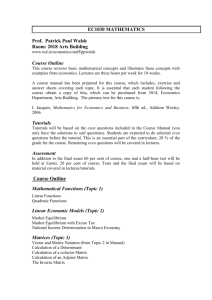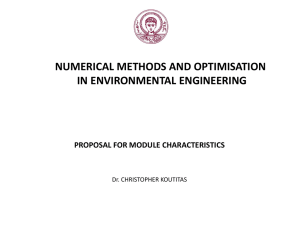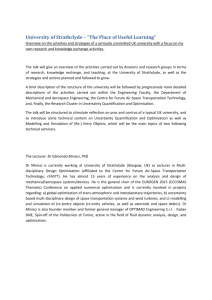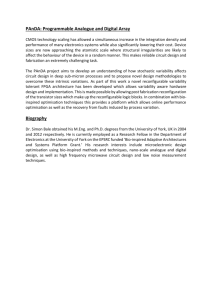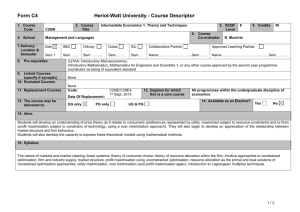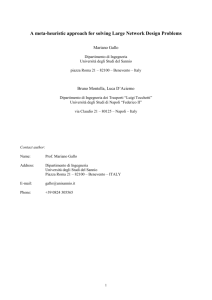Word
advertisement
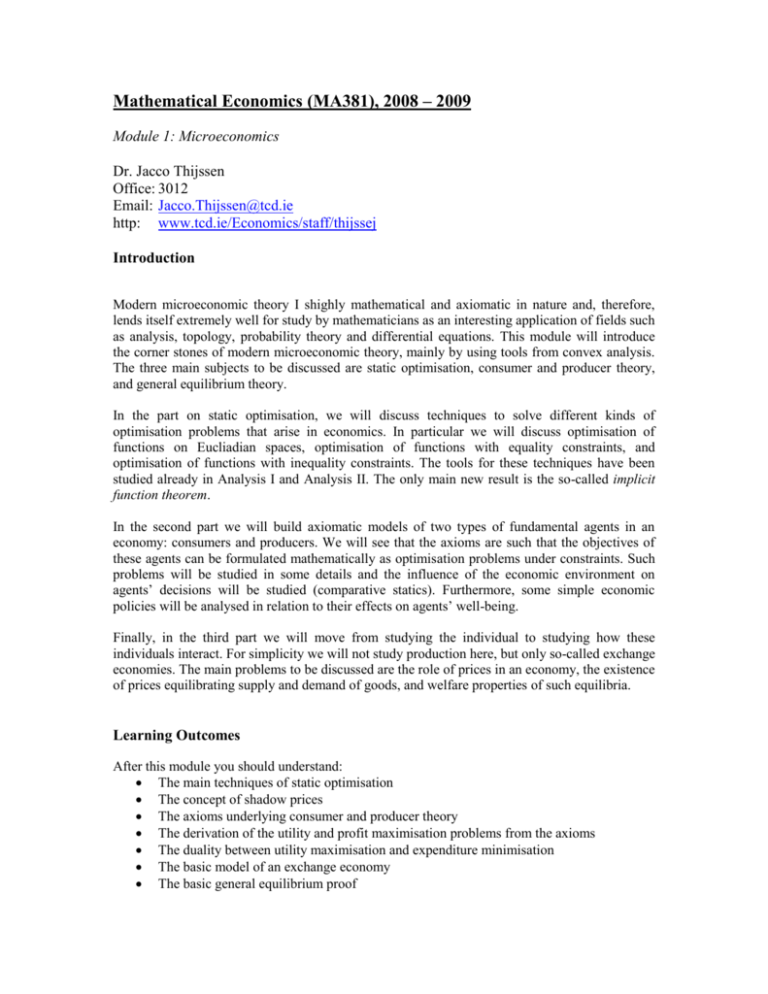
Mathematical Economics (MA381), 2008 – 2009 Module 1: Microeconomics Dr. Jacco Thijssen Office: 3012 Email: Jacco.Thijssen@tcd.ie http: www.tcd.ie/Economics/staff/thijssej Introduction Modern microeconomic theory I shighly mathematical and axiomatic in nature and, therefore, lends itself extremely well for study by mathematicians as an interesting application of fields such as analysis, topology, probability theory and differential equations. This module will introduce the corner stones of modern microeconomic theory, mainly by using tools from convex analysis. The three main subjects to be discussed are static optimisation, consumer and producer theory, and general equilibrium theory. In the part on static optimisation, we will discuss techniques to solve different kinds of optimisation problems that arise in economics. In particular we will discuss optimisation of functions on Eucliadian spaces, optimisation of functions with equality constraints, and optimisation of functions with inequality constraints. The tools for these techniques have been studied already in Analysis I and Analysis II. The only main new result is the so-called implicit function theorem. In the second part we will build axiomatic models of two types of fundamental agents in an economy: consumers and producers. We will see that the axioms are such that the objectives of these agents can be formulated mathematically as optimisation problems under constraints. Such problems will be studied in some details and the influence of the economic environment on agents’ decisions will be studied (comparative statics). Furthermore, some simple economic policies will be analysed in relation to their effects on agents’ well-being. Finally, in the third part we will move from studying the individual to studying how these individuals interact. For simplicity we will not study production here, but only so-called exchange economies. The main problems to be discussed are the role of prices in an economy, the existence of prices equilibrating supply and demand of goods, and welfare properties of such equilibria. Learning Outcomes After this module you should understand: The main techniques of static optimisation The concept of shadow prices The axioms underlying consumer and producer theory The derivation of the utility and profit maximisation problems from the axioms The duality between utility maximisation and expenditure minimisation The basic model of an exchange economy The basic general equilibrium proof The basic welfare properties of general equilibrium After this module you should be able to: Solve standard optimisation problems Solve standard utility and profit maximisation problems Apply Slutsky’s theorem to analyse welfare effects Solve for general equilibirum in simple exchange economies Solve for Pareto optimal allocations in simple exchange economies Find the core of simple exchange economies After this module you should have a critical attitude to: The axiomatic theory of economics Course Structure and Assessment There are two weekly one-hour lectures (Tuesday and Wednesday) and a weekly instruction class during which some exercises are demonstrated. The course will be assessed by a hand-in exercise and by a final examination. The term test consists of an exercise sheet, which has to be handed in at a date to be specified in due course. The term test counts for 10% towards your final grade. Literature The course will be based on lecture notes to be provided in due course. Students are well-advised to consult the following literature as well Simon, C.P. and L. Blume (1994), “Mathematics for Economists”, W.W. Norton & Company. (Especially Part IV on optimisation.) Mas-Colell, A., M.D. Whinston and J.R. Green (1995), “Microeconomic Theory”, Oxford University Press. (Especially Parts I and IV.) Varian, H. (1991), “Microeconomic Analysis”, W.W. Norton & Company. Hildenbrand, W. and A. Kirman (1988), “Equilibirum Analysis”, North-Holland. Debreu, G. (1959), “Theory of Value”, Cowles Foundation Monograph 17. (An absolute classic!) Magill, M. and M. Quinzii (1996), “Theory of Incomplete Markets”, MIT Press. (If you are interested in how general equilibrium theory can be used to analyse financial markets.) Shoven and Whalley (1992), “Applying General Equilibrium”, Cambridge University Press. (If you are interested in how general equilibrium can be used to analyse tax policy, trade policy, etc.) Florenzano, M. (2003), “General Equilibrium Analysis”, Kluwer Academic Publishers. (If you want to see the cutting-edge of general equilibrium research.) Detailed Outline Part I: Static Optimisation 1. Optimisation of functions on Rn. First-order conditions Second-order conditions 2. Optimisation of functions with equality constraints Implicit Function Theorem Theorem of Lagrange 3. Optimisation of functions with inequality constraints Theorem of Kuhn-Tucker Part II: Consumer and Producer Theory 4. Consumer Theory I Preference relations Utility functions Utility maximisation and Individual Demand 5. Consumer Theory II Duality theory Indirect utility and Hicksian demand Slutsky theorem 6. Producer Theory Production technologies Profit maximisation and cost minimisation Part III: General Equilibrium in Exchange economies 7. Exchange Economies Commodities and Prices Walrasian equilibrium Edgeworth box 8. Existence of Walrasian Equilibrium Excess demand Brouwer’s and Kakutani’s fixed point theorems Existence 9. Welfare properties of Walrasian equilibria Pareto optima First theorem of welfare economics Second theorem of welfare economics 10. Core and Walrasian equilibirum Core of an exchange economy Core and equilibrium
